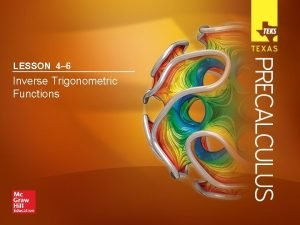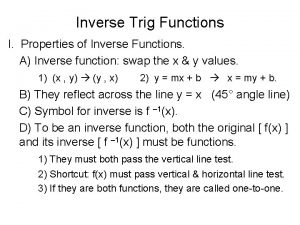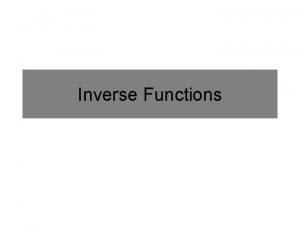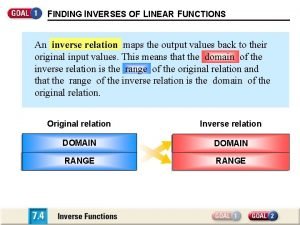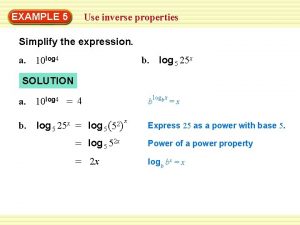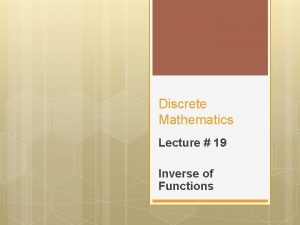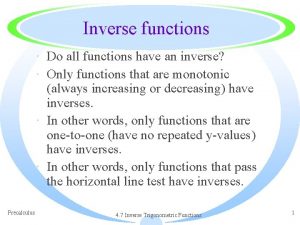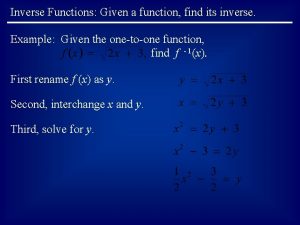Inverse Functions To have an inverse a function












- Slides: 12

Inverse Functions To have an inverse, a function must be one-to-one. This means for each x there is one and only one y and for each y there is one and only one x. Important note: If a function is always increasing (f’(x)>0) or if a function is always decreasing (f’(x)<0), then the function will be one-to-one. Therefore, we can check to see if a function is one-to one by checking its derivative. Mary Cundy & Gail Johnson Copyright 2002 Center for Statewide E-learning

The Horizontal Line Test is used to test a function for an inverse. If a horizontal line is drawn and intersects the graph at more than one point, the function does not have an inverse. The function has an inverse if the horizontal line intersects the graph at only one point. Mary Cundy & Gail Johnson Copyright 2002 Center for Statewide E-learning

The function y=x 2 fails the Horizontal Line Test and therefore doesn’t have an inverse. Note that f’(x) =2 x changes sign at x=0 Mary Cundy & Gail Johnson Copyright 2002 Center for Statewide E-learning

The function y=x+2 (note : f’(x) = +1 at all times) passes the Horizontal Line Test and has an inverse. Mary Cundy & Gail Johnson Copyright 2002 Center for Statewide E-learning

To find the inverse… 1. Use the Horizontal Line Test or check to see whether the first derivative is always positive or always negative. 2. Replace f(x) with y. 3. Exchange x and y then solve for y. 4. Replace y with f-1(x). 5. Check: f f-1 = x, f-1 f = x, and the graph. Mary Cundy & Gail Johnson Copyright 2002 Center for Statewide E-learning

f’(x) always positive !! Replace f(x) with y. Exchange x and y. Solve for y. Replace y with f-1(x). Check. Mary Cundy & Gail Johnson Copyright 2002 Center for Statewide E-learning

Check by graphing. The graph of the inverse is the graph of the function reflected across the line y=x. Mary Cundy & Gail Johnson Copyright 2002 Center for Statewide E-learning

Check with composition of functions. f f-1 f Mary Cundy & Gail Johnson Copyright 2002 Center for Statewide E-learning

f’(x) is always positive !! Replace f(x) with y. Exchange x and y. Solve for y. Replace y with f-1(x). Check. Mary Cundy & Gail Johnson Copyright 2002 Center for Statewide E-learning

Check by graphing. Mary Cundy & Gail Johnson Copyright 2002 Center for Statewide E-learning

The graph of f(x) and the graph of f-1(x) should reflect over the line y=x. y=f(x) y=x y=f-1(x) Mary Cundy & Gail Johnson Copyright 2002 Center for Statewide E-learning

Check with composition of functions. f f-1 f Mary Cundy & Gail Johnson Copyright 2002 Center for Statewide E-learning
 The inverse of exponential function is a composite function
The inverse of exponential function is a composite function Functions and inverses
Functions and inverses A solid figure with 6 faces 12 edges and 8 vertices
A solid figure with 6 faces 12 edges and 8 vertices Finding exact values of inverse trig functions
Finding exact values of inverse trig functions Inverse trig table
Inverse trig table Inverse functions
Inverse functions Domain and range of tan function
Domain and range of tan function Kazkhistan
Kazkhistan Inverse of linear function
Inverse of linear function Inverse log function
Inverse log function Simplify inverse trig functions
Simplify inverse trig functions Inverse functions linear discrete
Inverse functions linear discrete Log function properties
Log function properties



